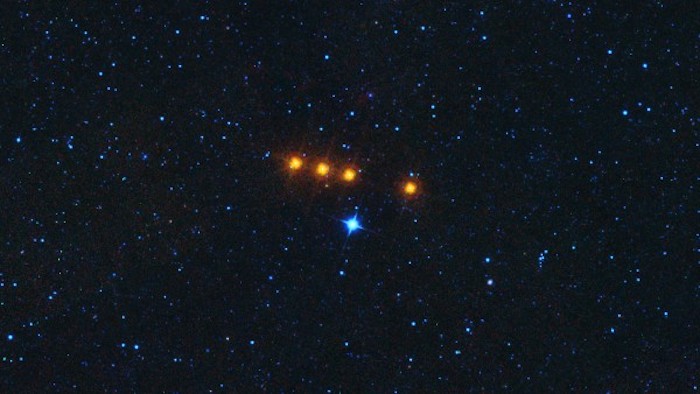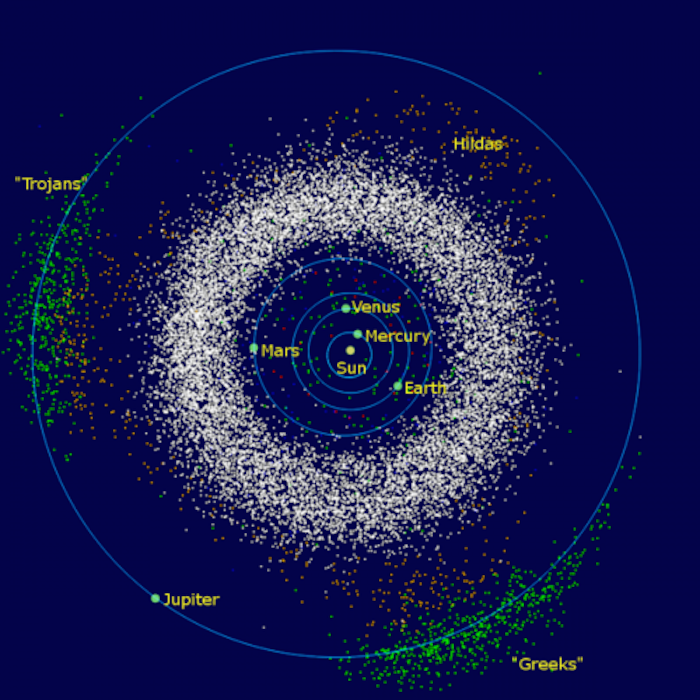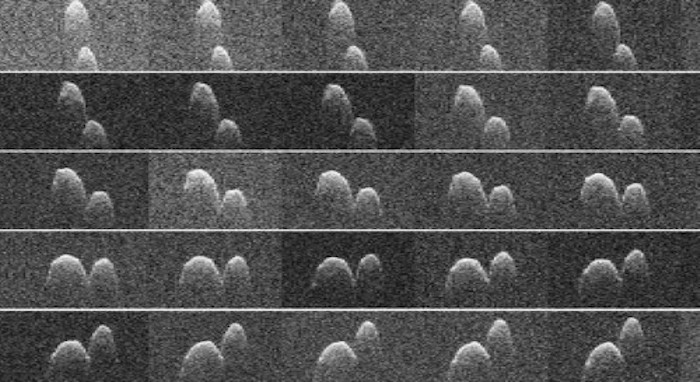.

Time-lapse view of the asteroid Euphrosyne as seen by NASA’s WISE spacecraft on May 17, 2010. WISE was later renamed to NEOWISE in 2013. Image Credit: NASA/JPL-Caltech
.
Near-Earth asteroids, also known as Near Earth Objects (NEOs), are some of the best studied space rocks in the Solar System, primarily due to the fact that they approach the orbit of Earth, making them potentially dangerous to our home planet. Now, a new study has provided evidence that at least some of them, including dark ones which are more difficult to see, originate from the oddball Euphrosyne family of dark asteroids which are at the outer edge of the main asteroid belt between Mars and Jupiter, but have highly inclined orbits well above the plane or “equator” of the Solar System.
The new study was conducted by scientists at NASA’s Jet Propulsion Laboratory in Pasadena, Calif., using the Near-Earth Object Wide-field Infrared Survey Explorer (NEOWISE) space telescope.
.

The main asteroid belt is between the orbits of Mars and Jupiter. The Euphrosyne asteroids, smaller in number, are in inclined orbits above the outer edge of the main belt. The Greeks and Trojans are other groups of asteroids sharing the orbital path of Jupiter. Image Credit: Mdf at English Wikipedia
NEOs are of particular interest to astronomers since their orbits bring them close to the orbit of Earth. By far, most pass safely by, but there is always the chance that one will collide with Earth, as has happened in the past. While some can originate from the main asteroid belt between Mars and Jupiter or from farther out in the Solar System, the new study suggests that some of the dark NEOs, on long and highly inclined orbits, originate from the Euphrosyne family of dark asteroids. Due to gravitational interactions with Saturn, Euphrosyne asteroids can become NEOs over timescales of millions of years.
“The Euphrosynes have a gentle resonance with the orbit of Saturn that slowly moves these objects, eventually turning some of them into NEOs,” said Joseph Masiero, the lead scientist on the study. “This particular gravitational resonance tends to push some of the larger fragments of the Euphrosyne family into near-Earth space.”
The Euphrosynes are named after the asteroid Euphrosyne—itself named for an ancient Greek goddess of mirth—one of the 10 largest objects in the main asteroid belt at 156 miles (260 kilometers) across. Euphrosyne is thought to be a remnant from a massive collision which formed all of the Euphrosyne asteroids about 700 million years ago.
Using NEOWISE, which sees in infrared light, scientists were able to better study many of the Euphrosyne asteroids—1,400 of them—measuring their sizes and amount of heat that they reflect. All of the asteroids were found to be large and dark, with highly inclined and elliptical orbits. In the main asteroid belt, there are over 700,000 known asteroids ranging in size from large boulders to about 60 percent the diameter of the Moon. With so many of them, it is difficult to find the specific point of origin for most NEOs.
“Most near-Earth objects come from a number of sources in the inner region of the main belt, and they are quickly mixed around,” Masiero said. “But with objects coming from this family, in such a unique region, we are able to draw a likely path for some of the unusual, dark NEOs we find back to the collision in which they were born.”
“NEOWISE is a great tool for searching for near-Earth asteroids, particularly high-inclination, dark objects,” Masiero added.
Since NEOs make close approaches to Earth, it is critical to better understand where they come from and how they behave. Most asteroids are safely far away from our planet, but NEOs play a kind of cat and mouse game; eventually one will hit the Earth again, and the more scientists know about them, the better we can prepare for a possible collision. This also of course helps astronomers to better understand asteroids in general, and what clues they provide to the origin and evolution of the Solar System, since asteroids are chunks of debris leftover from after the planets formed billions of years ago.
One such NEO, which just made a close pass of Earth on July 24, 2015, was the peanut-shaped asteroid 1999 JD6, which is between 660-980 feet (200-300 meters) in diameter. The images were obtained by pairing the 230-foot (70-meter) Deep Space Network antenna at Goldstone, Calif., with the 330-foot (100-meter) National Science Foundation Green Bank Telescope in West Virginia. The asteroid made its closest approach on July 24 at 9:55 p.m. PDT (12:55 a.m. EDT on July 25) at a distance of about 4.5 million miles (7.2 million kilometers, or about 19 times the distance from Earth to the Moon).
.

Radar images of near-Earth asteroid 1999 JD6, taken on July 25, 2015. Image credit: NASA/JPL-Caltech/GSSR
The NEOWISE space telescope was formerly known as WISE until the name was changed in 2013 when the telescope was reactivated after being decommissioned in 2011 and the transmitter turned off. WISE was initially launched Dec. 14, 2009, and was active from December 2009 to February 2011.
Future plans now include five tasks: 1) Reprocess the Post-Cryogenic Survey data collected after the depletion of the mission’s solid hydrogen to bring these data to the same level of calibration as the fully cryogenic dataset; 2) Optimize the WISE Moving Object Processing System (WMOPS) to enable extraction of moving objects at lower signal-to-noise levels and with fewer detections; 3) Deploy WMOPS on the entire NEOWISE dataset; 4) Perform stacking on the entire catalog of ~600,000 known minor planets to obtain detections of objects either too faint or with too few detections to have been found by WMOPS; 5) Compute physical properties for all objects detected in the NEOWISE data, either by stacking or with WMOPS, and deliver them to NASA’s Planetary Data System.
Quelle: AS
4364 Views
